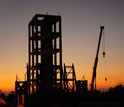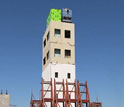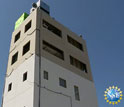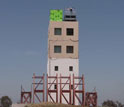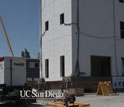Media Advisory 12-010
NSF Webcast: Testing for Earthquakes, Inside and Out
From an elevator to hospital beds, shake-table test will subject a five-story building's inner workings to severe motions from record-setting earthquakes

Illustration depicting several of the components contained in a massive shake-table experiment.
April 11, 2012
View a webcast with Tara Hutchinson and Jose Restrepo of UCSD and Joy Pauschke of NSF's NEES program.
View B-roll of the first and second April 17 shake tests; the May 11 shake test; and two views of the May 15 shake test (view 1 and view 2). Please contact Dena Headlee for a broadcast quality copy of this B-roll package.
This material is available primarily for archival purposes. Telephone numbers or other contact information may be out of date; please see current contact information at media contacts.
On April 17, 2012, an NSF-supported team of researchers will shake a full-size building outfitted with the myriad, inner workings of modern life.
From elevators to ceiling tiles, hospital equipment to computer servers and wiring to pipes, numerous non-structural elements will be tested as a five-story concrete building shakes from the motions of the devastating 1994 Northridge earthquake and the 2010 Chile earthquake."
The testing will take place atop the outdoor shake table at the Englekirk Structural Engineering Center at the University of California, San Diego (UC San Diego), part of NSF's 14-site national Network for Earthquake Engineering Simulation. Reporters can attend on-site or participate in a follow-on Q&A webcast hosted by NSF that afternoon.
To attend the shake, contact UC San Diego media officer Ioana Patringenaru at (858) 822-0899 or ipatrin@ucsd.edu for instructions and guidelines. We ask that media RSVP for the on-site event by noon April 16. To participate in the NSF Q&A webcast with study leads Tara Hutchinson and Jose Restrepo, along with NSF NEES program manager Joy Pauschke, contact NSF media officer Josh Chamot at (703) 292-7730 or jchamot@nsf.gov to receive the webcast participant passcode and phone number. Submit questions before and during the webcast to webcast@nsf.gov.
| Who: | Principal investigator Tara Hutchinson, Jacobs School of Engineering at UC San Diego; co-principal investigator Jose Restrepo, Jacobs School of Engineering at UC San Diego; NSF NEES program manager Joy Pauschke |
| What: | Full-scale shake test of five-story hospital/office building and its internal components and follow-on webcast |
| When: | Shake: April 17, 2012 beginning at noon EDT (9:00 a.m. PDT) NSF Webcast: April 17, 2012 at 2:00 p.m. EDT (11:00 a.m. PDT) |
| Where: | Shake: Englekirk Structural Engineering Center at UC San Diego NSF Webcast: http://live.science360.gov/ |
More information about the project, including upcoming fire tests, can be found at the project's website. Also see a short documentary film about the test produced by UCSD-TV and the California Seismic Safety Commission.
For more on another record-setting NSF NEES shake test, see Standing Strong. For detailed data showing NSF support of research in California, see NSF's Research.gov SEE Innovation website.
NSF's Directorate for Engineering is a world leader in support of research in engineering fields. In fiscal year 2011, the directorate provided $762.71 million in support of research at universities, businesses and other institutions throughout the United States.
-NSF-
-
View Video
UCSD engineers discuss shake test of a five-story building outfitted with non-structural elements.
Credit and Larger Version -
View Video
B-roll of the first April 17, 2012 shake test at UCSD.
Credit and Larger Version -
View Video
B-roll of the second April 17, 2012 shake test at UCSD.
Credit and Larger Version -
View Video
B-roll of the May 11, 2012 shake test at UCSD.
Credit and Larger Version -
View Video
B-roll of the May 15, 2012 shake test at UCSD.
Credit and Larger Version -
View Video
B-roll of the May 15, 2012 shake test at UCSD.
Credit and Larger Version
Media Contacts
Joshua A. Chamot, NSF, (703) 292-7730, email: jchamot@nsf.gov
Ioana Patringenaru, UC San Diego Jacobs School of Engineering, (858) 822-0899, email: ipatrin@ucsd.edu
Program Contacts
Joy M. Pauschke, NSF, (703) 292-7024, email: jpauschk@nsf.gov
Related Websites
Related UCSD press release with details of the experiment: http://go.usa.gov/yrC
The U.S. National Science Foundation propels the nation forward by advancing fundamental research in all fields of science and engineering. NSF supports research and people by providing facilities, instruments and funding to support their ingenuity and sustain the U.S. as a global leader in research and innovation. With a fiscal year 2023 budget of $9.5 billion, NSF funds reach all 50 states through grants to nearly 2,000 colleges, universities and institutions. Each year, NSF receives more than 40,000 competitive proposals and makes about 11,000 new awards. Those awards include support for cooperative research with industry, Arctic and Antarctic research and operations, and U.S. participation in international scientific efforts.
Connect with us online
NSF website: nsf.gov
NSF News: nsf.gov/news
For News Media: nsf.gov/news/newsroom
Statistics: nsf.gov/statistics/
Awards database: nsf.gov/awardsearch/
Follow us on social
Twitter: twitter.com/NSF
Facebook: facebook.com/US.NSF
Instagram: instagram.com/nsfgov



